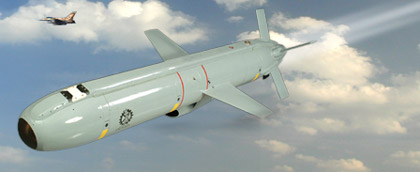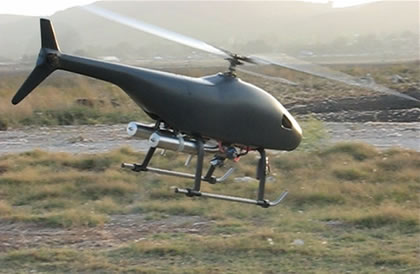AeroVironment, Inc. has been awarded a $5 million contract to develop a Stealthy, Persistent, Perch and Stare Air Vehicle System (SP2S) under a DARPA program. This small, stealthy UAV will be designed for close-range surveillance and reconnaissance missions. The basic platform will also combine the mission-adaptable perch-and-stare observation modes. DARPA has already received five early model SP2S vehicles used for initial military user evaluation (LTE). In the current phase, 10 additional systems will be delivered.
Pentagon’s unmanned systems spending Tops $5.4 billion in FY2010
U.S. spending on unmanned systems has steadily increased since 2001. In the next budget request the department of defense is seeking an increase of almost $870 million, more than 18.4 percent over the $4.53 billion spent this year. Last year the Pentagon spent $3.9 on UVS; Spending on unmanned systems has increased 37.5 percent over the past two years.
Among the UVS programs supported in the next budget, the procurement includes: five RQ-4 Global Hawk UAVs ($608 million) and 24 MQ-9 Reaper UAVs ($489 million.) They will be spending $2.13 billion, buying 36 Predators ($651 million), 704 Raven Small UAVs ($79 million) and $609 million will be spent RQ-7 Shadow tactical UAV system modifications. The Army is also planning to spend $125.6 million on unmanned ground vehicles (UGVs). These are included as part of the Future Combat Systems brigade combat team modernization program, for which the several new robots are being developed – including the iRobot Small UGV and Lockheed , working on the multifunction utility logistics equipment (MULE) UGV.
The U.S. Navy and Marine Corps are buying about $1 billion worth, about 80% is directed for research and development. The procurement budget will total about $180 million, including 11 RQ-7 Shadow UAV systems and 517 Ravens for the Marines, while the Navy will acquire five MQ-8 Fire Scout UAVs for $77.6 million.
The U.S. Special Operations Command (SOCOM) will also receive about $50 million to sustain operations of Reaper, Predator and Small Tactical UAS (STUAS).
Boeing Submits Proposal for USMC Unmanned Cargo Aircraft Demonstration
The U.S. Marine Corps Warfighting Laboratory is evaluating new means to resupply forward units, among the systems to be evaluated is the A160T Hummingbird developed by Boeing under a DARPA program. “The Marines have identified an urgent need for unmanned aerial vehicles to deliver supplies in lieu of putting trucks and personnel on dangerous roads,” said John Groenenboom, A160T program manager for Boeing. “The A160T was designed from inception, as a Unmanned Aerial Systems (UAS) with significant payload-carrying and high-altitude-operation capabilities, so we are confident in its ability to meet the requirements of this critical mission.” The A160T has a 2,500-pound payload capacity. Under the demonstration, Boeing will demonstrate the Hummingbird capability to deliver 2,500 pounds of cargo per day from one simulated forward-operating base to another, in fewer than six hours per day for three consecutive days. The autonomous unmanned aircraft can cruise at a speed exceeding 140 knots hover , and has demonstration hovering capability at an altitude of 20,000 ft.
The Hummingbird will also be used by the U.S. Special Operations Command plans, for the evaluation of the Forester foliage-penetration radar. The helicopters will be deployed with these radars in two Central American countries, early next year (2010) where they will be used to detect suspected hostile activity, concealed below the forest canopy.
Related Links:
Horizon Introduces a Lightweight Fuel cell for UAVs
A compact fuel cell power system recently introduced by Singapore based Horizon Fuel Cell Technologies offers up to four times the endurance capability of advanced lithium batteries currently in use. The lightweight fuel-cell power source called Aeropak was designed specifically for small UAVs. Storing 900Wh of usable electrical energy Aeropak weighs only 4.4 lbs (2kg). According to Horizon, the new power pack could extend the mission endurance of small, electrically powered UAVs by 300 percent. Horizon intends to offer the new fuel cell as a drop-in replacement for battery packs currently in service, eliminating costly airframe modifications. Aeropak uses refillable dry-fuel cartridges and is designed to sustain high impact and operation at altitude up to 22,000 feet (6500m). The company is planning to begin shipping evaluation models of Aeropak fuel cells this summer (2009).
The new fuel cell has been demonstrated has already been demonstrated in flight with the “Hyfish,” a 1kW fuel cell powered jet-wing UAS integrated by the German Air & Space Agency (DLR) and the “Pterosoar,” which set a new FAI world record for distance in 2007 with the support of NASA. The new AEROPAK will be displayed at the 2009 Paris Air Show (booth B075) alongside several UAS airframes powered by Horizon’s fuel cell power systems.
Related Links:
Heron MALE UAVs Assume maritime Surveillance Roles
Israel Aerospace Industries is conducting a series of operational demonstrations where potential customers are evaluating the Heron 1 Medium Altitude Long Endurance (MALE) UAV operated in maritime surveillance missions. In a recent test conducted in El-Salvador, U.S. Southern Command (SOUTHCOM) and Salvadoran military and civil aviation authorities conducted a month-long evaluation of the Heron, as part of ‘Operation Monitoreo’, assessing the suitability of unmanned aircraft for counter drug missions in the Pacific, Caribbean, Central and South America. Under a similar initiative that took place a few weeks ago, IAI held a joint demonstration for the Spanish Guardia Civil and the Spanish Air Force (SAF), demonstrating the maritime Heron Unmanned Aircraft System (UAS) in the Spanish Canary Islands. Yair Arbel, Chief of Flight Operations in MALAT, noted: “The demonstration took place partially under unfavorable weather conditions, with heavy cloud cover, pouring rain, strong winds and State 5 Seagoing. We detected small targets, as requested by Guardia Civil, in the designated area”.
The Spanish company reported the locations in real time to the Guardia Civil headquarters in Madrid, using systems which successfully interfaced with the IAI/MALAT Heron control station. The early detection of boats and vessels, some of them very small, carrying smuggled goods or illegal immigrants, is an important need for European Union countries. The Heron demonstrated how an unmanned platform can perform over extended mission duration, for up to 20 hours without the need for aerial refueling when configured for counter illicit trafficking detection missions. Earlier, in 2008 IAI performed a similar demonstration in Australia, where the Heron UAV was operated in support of customs patrols, evaluating its capability to control the northern coast.
Israel expects to begin flying maritime patrol sorties over the Mediterranean Sea with the UAV by mid-2009, gradually replacing its IAI Westwind 1124 business jet-based Seascans.
Related links:
Loitering Weapons are making a Comeback
Loitering munitions are making a comeback in recent years. First developed in the early 1980s as autonomous weapons, tasked primarily with Suppression of Enemy Air Defense (SEAD) missions, hunting down highly mobile air defense missile units such as the SA-8 and SA-11, then considered illusive to almost all other SEAD weapons. Western air forces have realized encountering a capability gap in their ability to find, target and engage land-mobile surface-to-surface ballistic missiles, after failing to destroy Iraqi SCUD missiles fired at Israel and Saudi Arabia, duribg Operation Desert Storm 1991, despite having total air superiority over the entire Iraqi airspace. Initially embarking on several developments of loitering weapons, the Israelis are considered having the first air force to maintain such capability, provided by the IMI Delilah missile. This weapon was developed after the 1973 Yom Kippur War and matured under a joint Israeli-German radar-hunter ‘suicide drone’ in the early 1980s.
An electro-optically guided derivative of this weapon was developed under an Israeli-US program in the early 2000s.
While the Germans did not pursue the lethal drone, opting for the Rheimetall Defense KZO
reconnaissance and target acquisition system version instead, Israel is believed to have followed the lethal direction, completing the development and fielding of the Harpy. This is considered to be among Israel’s leading missile products ever produced, gaining significant export markets, with China, South Korea, India and Turkey among its main international operators. The Germans have followed a similar developmental path with the Taifun killer drone. Recently, the German Armed Forces and the German Ministry of Defense (MOD) have also approved an operational requirement utilizing IAI’s HAROP system as a baseline. The project will be implemented in cooperation with Rheinmetall Defense as the prime contractor. The German MOD has already invested funds for the adaptation of HAROP for its specific requirements. Part of the adaptation was successfully performed by a joint IAI/Rheinmetall Defense team, and a follow on contract is planned later this year (2009).
Related links:
IAI Gets $100 Million Contract for HAROP Killer Drones
Officially unveiling the HAROP loitering weapon at the Paris Air Show, Israel Aerospace Industries (IAI) has announced receiving a contract to supply the HAROP Loitering Munition (LM) system to a foreign customer. Foreign sources hint the customer could be India. The contract is estimated to be worth over $100 million. Turkey is believed to be the launch customer for the HAROP, in 2005.

HAROP, a long endurance LM, can be launched from a variety of platforms. The expendable aerial vehicle combines the speed, precision and lethality of a guided missile with persistence, sensors and connectivity of a tactical UAV. HAROP can remain on a mission for six hours, performing area surveillance and reconnaissance, in support of specific area suppression and denial operations. It is fitted with an electro-optical payload, utilizing a high performance FLIR and color CCD, providing an electro-optical seeker, covering 360 degrees hemispherical field of regard. This sensor can search, detect and target, high value re-locateable, time critical, land or sea-based, moving targets, reporting their position with pinpoint accuracy, at long ranges.
When the operator decides to use the Harop for the final attack, the drone converts into an attack mode. The attack can be performed from any direction and at any attack angle, from flat to vertical, which is highly essential in urban area combat. Employing a steep-dive profile will also gain maximum speed and lethality. The 50 lb (23kg) high explosive charge is sufficient to cause significant damage to the target, while limiting collateral damage. The operator monitors the attack until the target is being hit. Another HAROP LM type can observe and send real-time video of Battle Damage Assessment (BDA) to the operator. The operator can command the drone to abort the attack, in order to avoid collateral damage, returning the LM to loitering mode, and restart the attack later. HAROP LMs are launched from transportable platforms and navigate towards the target area, where they loiter and search for designated targets.
A HAROP unit is comprised of LM launchers and a Mission Control Shelter (MCS) that enables missile control with a Man- in the- Loop operation, engagement or abort attack capability in real time, avoiding collateral damage. The HAROP can be applied to a variety of battle scenarios, including low and high-intensity conflicts, urban warfare and counter terror operations.
Related links:
- Israel Unveils Loitering Anti-Missile Drone: Harop
- Israel, Germany Sign Cooperation Agreement for the Development of Loitering Weapons
- Hunter Killer drone target Ballistic Missile Launchers
- Harpy Air Defense Suppression System
- Loitering Weapons are making a Comeback
- Delilah – The IAF Loitering Missile

EADS Unveils Advanced UAV at the Paris Airshow

EADS is unveiling at the Paris Air Show the latest version of the Advanced UAV System. The new UAV is positioned by EADS to fulfill European requirements for High Altitude Intelligence collecting platform, fitted with a wing span 27.9 meters, the UAV will be capable of flying at a maximum altitude of 50,000 ft, on a 24 hour mission. The Advanced UAV will be designed for maximum takeoff weight of seven tons, carrying an external payload of one ton.

In May 2009 and EADS Defence & Security (DS) concluded an 15 months €60 million risk reduction study undertaken with cooperation of France, Germany and Spain, planning for the tri-national Advanced UAV. According to EADS’ Senior Vice President for Mission Air Systems Nicolas Chamussy, “The common understanding between the partners for the joint Advanced Unmanned Aerial Vehicle for ISTAR (Intelligence, Surveillance, Target Acquisition and Reconnaissance) missions, as described in our study, is another stable pillar of European security.” Nicolas Chamussy is the integrated DS business unit Military Air Systems (MAS). He said the Advanced UAV will incorporate the most modern, modular sensor suite and data links, which are vital for sustainable and reliable ISTAR missions, which contemporary off-the-shelf platforms never can achieve. “The Advanced UAV project, once launched soon, will give our customers operational flexibility, a permanent awareness picture on critical security hot spots home or abroad, and autonomy from third parties’ equipment and intelligence, surveillance and reconnaissance (ISR) results”, Chamussy stated.
The configuration displayed on a full-scale model at the Paris Air Show represents the resolution of requirements set by the different partners. The aerial vehicle is powered by two dorsal mounted turbojet engines, clearing the mid-section and belly for carrying mission payloads. The aircraft employs a forward mounted radar, with retractable, large focal plane multi-sensor payload employing large apperture optics. Electronic surveillance probes are grouped at the sides and the tail, where another rear-looking radar is emplaced. COMINT gear is associated with fuselage mounted antennae emplaced in the lower forward section while the upper section is cleared for the satellite communications datalink and avionics.
“For the Risk Reduction Study, which we received in late 2007, a joint team of dedicated engineers from DS in France, Germany and Spain was working very hard to deliver a tailor-made solution satisfying the common needs for an Advanced UAV for the Armed Forces of France, Germany and Spain. The close dialogue with the customers around the Advanced UAV Battle-lab has proved a unmatched tool to harmonize requirements and optimize the solution”, said Chamussy.
EADS’ Advanced UAV team included Thales, which led the radar sub-team Indra in Spain, leading defense electronics activities. The twin-jet propulsion system of the Advanced UAV will not only supply ample on-board energy for the satellite communications, sensors and data links, but also safeguard secure flight conditions in the densely populated skies over Europe”, Chamussy explained.
Given a positive response from the partner nations, EADS expects a development contract worth €1.5 billion by next year. France and Germany could be interested in buying six systems each, with Spain opting for three. Turkey has also expressed interest in the program.
Related Links:
Delilah – The IAF Loitering Missile
For over 20 years Delilah was officially defined as a ‘Suppression of Enemy Air Defense (SEAD) powered decoy, but behind the curtain of secrecy, the Israel Air Force and IMI developed an innovative and unique weapon, that has served the IAF well in the past 20 years.
Originally, Delilah and Samson were developed for the IAF as part of an IMI family of SEAD decoys. However, while Samson continued to evolve as a decoy, that became a successful export product, Delilah disappeared from the ‘radar screens’ and kept a very low profile, becoming one of the air force’s top secret programs. Through its transformation, the decoy evolved into a ‘loitering precision attack weapon’, combining the capabilities of an unmanned aerial vehicle and guided missile, capable of attacking enemy targets with unprecedented precision, agility and persistence.
The weapon’s imaging sensors, smart mission-control and two-way datalink, enable ‘human in the loop’ control which, coupled with extended loitering capability, offering Delilah unprecedented combat capabilities. The weapon can be used to accurately and selectively attack a target at it’s weakest points, for example, targeting a protected command center. In this mode, Delilah can be aimed to strike a specific part of the structure, or disable a vital communications link, without destroying the entire target. The weapon’s loitering capability proves an essential feature, when targets are hidden, concealed, or difficult to identify on the first pass, or if the conditions do not match prior assessment. Under such conditions Delilah is commanded to ‘go around’, wait for better conditions or strike the target from a different angle.
Since Delilah entered service with the IAF in the early 1990s, the weapon went through periodical evolution primarily through Block upgrades. The different missiles may look the same, but their capabilities have significantly been improved over the years. The first production models of the Delilah were integrated only in the Israeli F-4E. It was later introduced to the improved Phantom-2000, F-16C/D and, most lately to F-16I (Israeli Block 52) models. Delilah is currently being evaluated by a number of foreign navies, for use as land attack and anti-ship weapon, carried by naval helicopters.
“Delilah is our ‘flagship of weapons’, the most advanced ground attack weapon the IAF has” says Lt. Colonel Gil, head of ordnance branch in the Air Force’s Weapon Systems Division. Primary use of this weapon is the hunting for targets, such as surface missiles and launchers, rocket launching sites, and surface-to-air weapons. Over the years we also introduced an anti-structure warhead to improve our effectiveness against fortified and urban targets.” During the 2nd Lebanon War the air force used ordnance, representing almost every type of weapon in its arsenal. Delilah missiles were also used, hunting of Hezbollah supply trucks. The missiles tracked vehicles carrying rocket loads, crossing from Syria and destroyed them inside Lebanon.” Lt. Col. G admits Delilah is an expensive weapon that cannot be commonly employed, but only selectively, when the target ‘value’ justifies the cost. The IAF continues to evolve the system, into future weapons that will continue and expand the Delilah concept and its capabilities. Furthermore, the IAF recently upgraded the weapon simulator of the Delilah, to reflect the latest capabilities of the weapon.
Unmanned Power Gliders Assume Long Endurance Surveillance Patrols
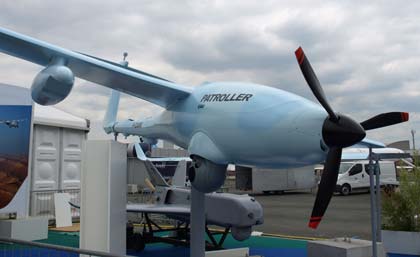
The French UAV maker Sagem has teamed with German glider producer Stemme AG to introduce the Patroller, a long endurance UAV based on a powered glider. The Stemme S 15 was first presented at the Berlin Air-Show last in 2008. In its current configuration, the Patroller is designed to perform long endurance missions, to be used in a wide spectrum of roles, from military surveillance to homeland security and maritime patrol. The unmanned Patroller will be capable of flying a 20-hour mission carrying a 440-pound payload. The aircraft carries the Euroflir electro-optical sensor payload provided by Sagem of France, and a pod mounted SAR radar provided by the German company OHB, carried underwing. Stemme is also offering an optionally piloted configuration of the drone. These aircraft are controlled through the LAPAZ flight control system and employ the Aerial Real Time Intelligence and Surveillance (ARTIS), both developed by Stemme.
Rafael introduces RecceLite pod for UAV’s
Rafael Advanced Defense Systems Ltd. will release the Recce-U, persistent, unmanned, surveillance and reconnaissance system at the Paris Air Show next week.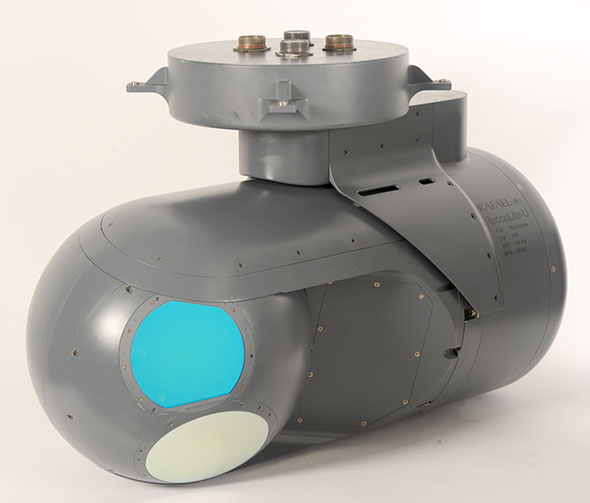
Recce-U is a self-contained, multi-sensor ISR system for the UAV platform, based on the RecceLite tactical reconnaissance pod for combat aircraft. Recce-U simultaneously collects high-resolution infrared and visual digital images, day and night, within a very wide field of regard, in accordance with an automatic mission plan and/or manual operation, and transmits the images, which are then viewed and interpreted in real time at the ground exploitation station. The Recce-U system comprises a persistent ISR payload, Ground Data Link Station (GDLS) and Ground Exploitation Station (GES).
The Reccu-U system is revolutionary in that the inertial LOS control enables routine scanning of extremely wide areas irrespective of the UAVs maneuvers and facilitates IED detection as well.
David Stemer, Corporate Vice President, General Manager Missiles & NCW Division, says that “Rafael is proud of its new addition to its electro-optic systems together with the outstanding capabilities of the Recce-U system strengthen the premise that Rafael is indeed a world leader in electro-optic and image processing systems.”

More than Just a Weather Forecast
The Critical Role of Accurate Weather Data in UAV Missions / Lee Nelson
Unmanned aircraft are becoming an increasingly important part of defense strategies; helping military personnel respond to a greater demand for improved surveillance and attack operations. These sophisticated unmanned aerial vehicles (UAVs) offer enhanced flexibility, speed, intelligence and a reduced risk of loss of life. The most notorious UAV is the General Atomics Predator, which first was responsible for reconnaissance missions. It later launched missiles at targets in Afghanistan, Iraq and regions of Pakistan. But without a pilot on-board, the success of UAV flights depends heavily on accurate information and reporting.
One crucial type of data for UAV flights is real-time weather information. This information is especially important during take-off and landing, with 84 percent of Predator mishaps occurring during the landing process, according to a large supplier of unmanned aircraft. Real-time weather data is typically gathered from a quick-deployment automatic weather station to support operations. As pilots and military personnel coordinate UAV flights, having information on wind speed and direction, barometric pressure, cloud coverage, thunderstorms and visibility may mean the difference between an effective landing or take-off, and a failed one.
A Closer Look at UAV Operations
As many news sources have recently reported, government intelligence sources consider these UAVs to be one of their most effective weapons against Al Qaeda. The demand for UAVs is increasing, according to the Department of Defense (DOD). In 2003, when the United States invaded Iraq, the DOD planned to increase its UAV inventory to about 350 by 2010, however this number has already been achieved. The Army has about 250 Shadow UAVs, followed by the Air Force with about 110 Predators and 30 Reapers. Small UAVs, sizing only a few feet, are also an effective tool in battlefield surveillance platforms.
Strategic UAVs are often operated remotely with pilots manning the controls in Nevada while the aircraft is based in the Middle East. These pilots rely on accurate information and real-time data to accomplish successful missions. As the New York Times recently noted, Predators and the Air Force’s Reapers are now flying 34 surveillance patrols each day in Iraq and Afghanistan, up from 12 in 2006. They are also transmitting 16,000 hours of video each month, some of it directly to troops on the ground.
The UAV technology is advancing rapidly but is yet to be perfected, however, as Air Force officials acknowledge that more than a third of their unmanned Predator spy planes have crashed. Of these Predator crashes, 55 were lost because of weather conditions, equipment failure or operator errors. With price tags averaging around $4.5 million for the 27-foot Predator, maintaining these valuable pieces of equipment is important in achieving our national defense objectives.
Weather: Direct Impact on UAVs
As with traditional defense aviation, accurate and timely weather data allows UAV pilots to make informed decisions. However, UAVs are more susceptible to weather conditions, according to a 2005 report from the United States Government Accountability Office (GAO). According to the GAO, weather and environmental constraints, including dust and sand storms, limit UAV operations. For example, Marine Corps UAVs have been kept from performing certain missions as a result of dust storms. Having accurate weather reporting enables ground personnel to make the best decisions for UAV flights.
UAV pilots use accurate weather information to plan and execute effective fuel management, diversions and alternate route planning. Information on wind speed and direction, cloud ceiling, visibility, precipitation, humidity and temperature is crucial for flight plan preparation and execution. Many unmanned aircraft often fly at lower altitudes, causing them to be directly affected by the weather.
Effective communication between military personnel in the field and back home can be the key to a successful UAV mission. It is important to use technology that is designed specifically to meet the demands of defense communication in the field, which means equipment that is rugged, versatile and easily assembled in a variety of defense situations. Although situations may vary based on the time of year, region and purpose of the mission, there are a few basic principals of weather measurement to keep in mind for each phase of a UAV flight.
Take-Off
During a UAV take-off it is essential that pilots have accurate, on-demand reporting of wind-speed and direction, atmospheric pressure, humidity and visibility in the take-off area. Additionally, reporting of cloud cover and precipitation can help pilots determine if conditions are favorable for a safe take-off. Depending on the climate, extreme weather during take-off conditions, such as rain, snow and dust storms can inhibit the course of a UAV. Real-time weather data acts as the eyes and ears of a pilot responsible for a plane remotely.
In-Flight
As mentioned, many UAVs often fly at lower altitudes, so they are directly affected by the weather. Accurate information about such phenomena as precipitation, cloud height and depth, and humidity can help pilots make decisions about route planning and alterations, as well as fuel management. Unlike traditional aircraft, a pilot for a UAV cannot glance out the window to check the condition of the plane during flight. A common problem for UAVs, especially during longer flights, is ice accumulation on the wings and body of the vehicle. Pilots and weather officers can use real-time reporting as well as model forecast data to determine the safety of a UAV based on current and future weather conditions.
Safe Landing
In preparation for a landing, pilots need accurate information on wind speed and direction (especially runway cross-winds), atmospheric pressure, temperature and humidity (used to calculate density altitude), and precipitation in the landing area. Hazardous weather conditions, such as freezing rain and thunderstorms, may be detrimental to a UAV landing if pilots are misinformed. Thunderstorm data measured by tactical lightning detectors indicate the presence of lightning strikes in the area. With accurate weather reporting, weather officers and pilots can determine which approach can be used, and even in some cases whether an approach should be attempted or an alternate landing base is required.
Accurate Weather Information a Best Practice
Similar to the best practices of traditional defense aviation, accurate and real-time weather information is mission critical. Whether a UAV mission is tactical and centered on information-gathering, or defense and attack initiatives or a strategic reconnaissance mission, UAVs’ role in the Department of Defense is increasing. As the demand for UAVs grows, so will the need for on-demand weather information, such as wind speed and direction, ceiling, visibility, atmospheric pressure, and present weather (i.e. rain, snow, thunderstorms, etc.). This crucial weather intelligence will improve UAV safety in take-off, flight and landing, and assist defense missions in achieving objectives.
About the Author:
Lee Nelson is New Applications Manager for the Vaisala Defense Segment. He is a retired United States Air Force Weather Officer. He can be reached at [email protected]. Vaisala is a global leader in environmental and industrial measurement. Building on more than 70 years of experience, Vaisala contributes to a better quality of life by providing a comprehensive range of innovative observation and measurement products and services for meteorology, weather critical operations and controlled environments. Headquartered in Finland, Vaisala employs over 1200 professionals worldwide and is listed on the NASDAQ OMX Helsinki. www.vaisala.com
IDF Approves Acquisition of IMI’s Iron Fist Active protection Systems for Namer AIFVs
The Israel Defense Forces (IDF) is moving forward with the development and fielding of active protection systems (APS) for tanks and armored infantry fighting vehicles (AIFV). Maj. General Dan Harel, IDF 2nd in Command has approved the acquisition of IMI ‘Iron Fist’ APS for the Namer AIFVs, parallel to the continued acquisition of Aspro-A (Trophy) systems for the Merkava 4 tanks. Currently in advanced developmental phase, Iron Fist is expected to provide multi-level protection against anti-tank threats, from short range tandem-warhead rockets that demonstrated their ability to defeat reactive armor, to sophisticated, heavy guided missiles such as the Kornet, employed by the Hezbollah during the 2006 2nd Lebanon War. The system has also been designed to counter tank fired (kinetic) threats. Each Iron-Fist system employs two turrets, containing two launch tubes firing the interceptor projectile (shown above, near an RPG rocket used for test firing) and several types of sensors, covering 360 degrees. The system can also include various countermeasures, which could attempt to engage threats at extended range with ‘soft kill’, saving ‘hard kill’ means as the last line of defense. By utilizing soft launch techniques, firing loads generated by the Iron Fist are reducing potential adverse effect on the platform’s mobility or fire accuracy.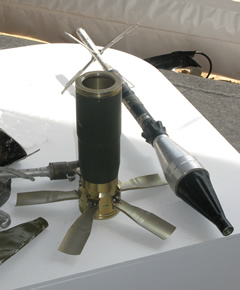
Meanwhile, operational testing continue with Merkava 4 tanks fitted with Rafael’s Trophy APS. The IDF is expected to announce the system ‘operational ready’ upon the completion of this final Technology Readiness Level (TRL) testing. The test includes the deployment of Aspro-A equipped tanks with unit-level training exercises, evaluating the handling and integration of the systems by combat crews and their integration with operational tanks. Further systems are deployed with the Israeli Armor Center, where tactical concepts of operations (CONOPS) are developed by the Armor School. According to initial reports, the systems are performing well under field conditions. All IDF Merkava Mk4 tanks produced in recent months are being prepared for installation of the Aspro-A, making field deployment of the system, once it officially declared ‘operational capable’. For the initial phase the IDF has considered to outfit a complete Merkava Mk4 tank brigade with the system, and possibility to mount yet another type of ADS the new Namer Armored Infantry Fighting Vehicle (AIFV), derived from the Merkava platform, which is also in production. However, prevailing budget cuts could lead the military to delay the schedules of certain systems, as air power, armor, counter rocket, artillery and mortars defenses (C-RAM) and strategic missile defense compete for MoD funding priorities.
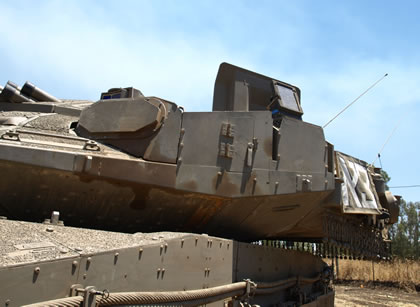
Steadicopter Introduces Black Eagle 50 – Lightweight Unmanned Helicopter
The Israeli company Steadicopter has introduced a lightweight, unmanned rotorcraft designed for surveillance and security applications for military and commercial use. The new helicopter employs a proprietary flight control system enabling fully autonomous operation and use by untrained operators. It will use a new and lightweight multi-sensor payload developed by TopiVision. The company is also working on a larger ‘Black Eagle 60’ that will be capable of carrying a 10kg payload flying 4 hour missions.
The Black Eagle 50 can be used as a flying, robotic observation system for civilian and military applications. The system comprises two helicopters, a communications module maintaining video data-link between the airborne helicopter and the ground control station. The nominal datalink range is 10 kilometers. This distance can be extended up to 150 km, using more powerful gear and directional antennae. The 35kg Black Eagle 50 is designed to carry payloads of up to 3 kg on a three-hour mission. Powered by a 116cc water-cooled engine the Black Eagle 50 can sustain an air speed up to 70 knots (126 km/h) and cruise at 47 knots (85 km/h). It can operate at altitudes up to 9,000 ft, take off and land at winds of 25 knots (45 km/h). At present, the helicopter carries the TopiVision Lev-6 multi-sensor gyro-stabilized sensor payload weighing only 1.5 kg, thus leaving adequate space and weight for additional mission systems. Each helicopter is equipped with the Lev-6 gyro-stabilized, day and night multi-sensor payload weighing only 1.5 kilograms. On the mission the Black eagle flies fully autonomously while the operator controls the payload’s line of sight and footprint from his console. If required, the helicopter can be controlled via the emergency command uplink.
The Israeli company Steadicopter, specializing in the design and development of unmanned rotary-wing platforms has developed a small unmanned rotorcraft employing a proprietary flight control System based on a patent registered by the company’s founders. Established in 1999 as a Technion entrepreneurial incubator company, Steadicopter began its way as a developer of automatic flight control for helicopters. The company also applied this know-how to offer stabilization and controlling of unmanned rotorcraft, applicable for any helicopter of all sizes. The company launched its first unmanned robotic helicopter (RUAV) demonstrator in 2004, demonstrating fully autonomous, vertical take-off, flight between waypoints and landing. In recent years the company developed a complete Unmanned Aerial System (UAS) platform, designated ‘Black Eagle’, introducing a robust helicopter design, controlled by a flight computer, mission computer and ground control system all developed and produced by Steadicopter. For large platforms Steadicopter has developed a conversion kit, suitable for large helicopters. This kit converts a manned helicopter to an unmanned helicopter.

